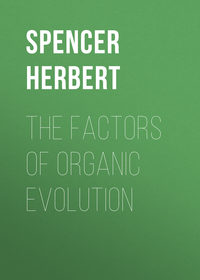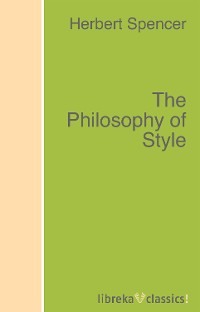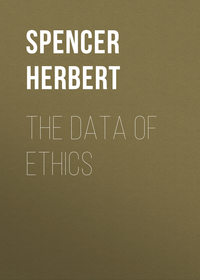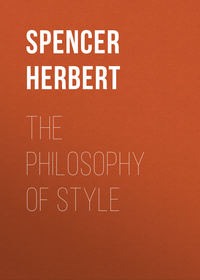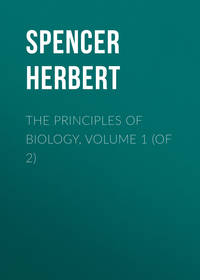 полная версия
полная версияFirst Principles
It was pointed out, however, that though this species of transformation is universal, in the sense of holding throughout all classes of phenomena, it is not universal in the sense of being continued without limit in all classes of phenomena. Those aggregates which exhibit the entire change from uniformity to multiformity of structure and function, in comparatively short periods, eventually show us a reverse set of changes: Evolution is followed by Dissolution. The differentiations and integrations of Matter and Motion, finally reach a degree which the conditions do not allow them to pass; and there then sets in a process of disintegration and assimilation, of both the parts and the movements that were before growing more united and more distinct.
But under one or the other of these processes, all observable modifications in the arrangement of things may be classed. Every change comes under the head of integration or disintegration, material or dynamical; or under the head of differentiation or assimilation, material or dynamical; or under both. Each inorganic mass is either undergoing increase by the combination with it of surrounding elements for which its parts have affinity; or undergoing decrease by the solvent and abraiding action of surrounding elements; or both one and the other in varied succession and combination. By perpetual additions and losses of heat, it is having its parts temporarily differentiated from each other, or temporarily assimilated to each other, in molecular state. And through the actions of divers agents, it is also undergoing certain permanent molecular re-arrangements; rendering it either more uniform or more multiform in structure. These opposite kinds of change, thus vaguely typified in every surrounding fragment of matter, are displayed in all aggregates with increasing distinctness in proportion as the conditions essential to re-arrangement of parts are fulfilled. So that universally, the process of things is either in the one direction or the other. There is in all cases going on that ever-complicating distribution of Matter and Motion which we call Evolution; save in those cases where it has been brought to a close and reversed by what we call Dissolution.
§ 140. Whether this omnipresent metamorphosis admits of interpretation, was the inquiry on which we next entered. Recognizing the changes thus formulated as consisting in Motions of Matter that are produced by Force, we saw that if they are interpretable at all, it must be by the affiliation of them on certain ultimate laws of Matter, Motion, and Force. We therefore proceeded to inquire what these ultimate laws are.
We first contemplated under its leading aspects, the principle of correlation and equivalence among forces. The genesis of sensible motion by insensible motion, and of insensible motion by sensible motion, as well as the like reciprocal production of those forms of insensible motion which constitute Light, Heat, Electricity, Magnetism, and Chemical Action, was shown to be a now accepted doctrine, that involves certain corollaries respecting the processes everywhere going on around us. Setting out with the probability that the insensible motion radiated by the Sun, is the transformed product of the sensible motion lost during the progressive concentration of the solar mass; we saw that by this insensible motion, are in turn produced the various kinds of sensible motion on the Earth’s surface. Besides the inorganic terrestrial changes, we found that the changes constituting organic life are thus originated. We were obliged to conclude that within this category, come the vital phenomena classed as mental, as well as those classed as physical. And it appeared inevitably to follow that of social changes, too, the like must be said. We next saw that phenomena being cognizable by us only as products of Force, manifested under the two-fold form of attraction and repulsion, there results the general law that all Motion must occur in the direction of least resistance, or in the direction of greatest traction, or in the direction of their resultant. It was pointed out that this law is every instant illustrated in the movements of the celestial bodies. The innumerable transpositions of matter, gaseous, liquid, and solid, going on over the Earth’s surface, were shown to conform to it. Evidence was given that this same ultimate principle of motion underlies the structural and functional changes of organisms. Throughout the succession of those nervous actions which constitute thought and feeling, as also in the discharge of feeling into action, we no less found this principle conspicuous. Nor did we discover any exception to it in the movements, temporary and permanent, that go on in societies. From the universal coexistence of opposing forces, there also resulted the rhythm of motion. It was shown that this is displayed from the infinitesimal vibrations of molecules up to the enormous revolutions and gyrations of planets; that it is traceable throughout all meteorologic and geologic changes; that the functions of every organic body exemplify it in various forms; that mental activities too, intellectual and emotional, exhibit periodicities of sundry kinds; and that actions and reactions illustrating this law under a still more complex form, pervade social processes.
Such being the principles to which conform all changes produced by Force on the distribution of Matter, and all changes re-actively produced by Matter on the distribution of Force, we proceeded to inquire what must be the consequent nature of any re-distributions produced: having first noted the limiting conditions between which such re-distributions are possible, and the medium conditions that are most favourable to them. The first conclusion arrived at, was, that any finite homogeneous aggregate must inevitably lose its homogeneity, through the unequal exposure of its parts to incident forces. We observed how this was shown in surrounding things, by the habitual establishment of differences between inner and outer parts, and parts otherwise dissimilarly circumstanced. It was pointed out that the production of diversities of structure by forces acting under diverse conditions, has been illustrated in astronomic evolution, supposing such evolution to have taken place; and that a like connection of cause and effect is seen in the large and small modifications undergone by our globe. In the early changes of organic germs, we discovered further evidence that unlikenesses of structure follow unlikenesses of relations to surrounding agencies – evidence enforced by the tendency of the differently-placed members of each species to diverge into varieties. We found that the principle is also conformed to in the establishment of distinctions among our ideas; and that the contrasts, political and industrial, that arise between the parts of societies are no less in harmony with it. The instability of the homogeneous thus caused, and thus everywhere exemplified, we also saw must hold of the unlike parts into which any uniform whole lapses; and that so the less heterogeneous must tend continually to become more heterogeneous – an inference which we also found to be everywhere confirmed by fact. Carrying a step further our inquiry into these actions and reactions between Force and Matter, there was disclosed a secondary cause of increasing multiformity. Every differentiated part becomes, we found, a parent of further differentiations; not only in the sense that it must lose its own homogeneity in heterogeneity, but also in the sense that it must, in growing unlike other parts, become a centre of unlike reactions on incident forces; and by so adding to the diversity of forces at work, must add to the diversity of effects produced. This multiplication of effects, likewise proved to be manifest throughout all Nature. That forces modified in kind and direction by every part of every aggregate, are gradually expended in working changes that grow more numerous and more varied as the forces are subdivided, is shown in the actions and reactions going on throughout the Solar System, in the never-ceasing geologic complications, in the involved symptoms produced in organisms by disturbing influences, in the many thoughts and feelings generated by single impressions, and in the ever-ramifying results of each new agency brought to bear on a society. To which add the corollary, confirmed by abundant facts, that the multiplication of effects must increase in a geometrical progression, as the heterogeneity increases. Completely to interpret the structural changes constituting Evolution, there remained to assign a reason for that increasingly-distinct demarcation of parts, which accompanies the production of differences between parts. This reason we discovered to be, the segregation of mixed units under the action of forces capable of moving them. We saw that when the parts of an aggregate have been made qualitatively unlike by unlike incident forces – that is, when they have become contrasted in the natures of their component units; there necessarily arises a tendency to separation of the dissimilar orders of units from each other, and to aggregation of those units which are similar. This cause of the integration that accompanies differentiation, turned out to be likewise exemplified by all kinds of Evolution – by the formation of celestial bodies, by the moulding of the Earth’s crust, by organic modifications, by the establishment of mental distinctions, by the genesis of social divisions. And we inferred, what we may everywhere see, that the segregation thus produced goes on so long as there remains a possibility of making it more complete. At length, to the query whether the processes thus traced out have any limit, there came the answer that they must end in equilibration. That continual division and subdivision of forces, which is instrumental in changing the uniform into the multiform and the multiform into the more multiform, we saw to be at the same time a process by which force is perpetually dissipated; and that dissipation, continuing as long as there remains any force unbalanced by an opposing force, must end in rest. It was shown that when, as happens with aggregates of various orders, a number of movements are going on in combination, the earlier dispersion of the smaller and more resisted movements, entails the establishment of different kinds of moving equilibria: forming transitional stages on the way to complete equilibrium. And further inquiry made it apparent that for the same reason, these moving equilibria have a certain self-conserving power; shown in the neutralization of perturbations, and the adjustment to new conditions. This general principle, like the preceding ones, proved to be traceable throughout all forms of Evolution – astronomic, geologic, biologic, mental and social. And our concluding inference was, that the penultimate stage of this process, in which the extremest degree of multiformity and completest form of moving equilibrium is established, must be one implying the highest conceivable state of humanity.
Thus it became apparent that this transformation of on indefinite, incoherent homogeneity into a definite coherent heterogeneity, which goes on everywhere, until it brings about a reverse transformation, is consequent on certain simple laws of force. Given those universal modes of action which are from moment to moment illustrated in the commonest changes around us, and it follows that there cannot but result the observed metamorphosis of an indeterminate uniformity into a determinate multiformity.
§ 141. Finally, we have asked whether, for these universal modes of action, any common cause is assignable – whether these wide truths are dependent on any single widest truth. And to this question we found a positive answer. These several principles are corollaries from that primordial principle which transcends human intelligence by underlying it.
In the first part of this work it was shown, by analysis of both our religious and our scientific ideas, that while knowledge of the cause which produces effects on our consciousness is impossible, the existence of a cause for these effects is a datum of consciousness. Though Being is cognizable by us only under limits of Time and Space, yet Being without limits of Time and Space was proved to be the indefinite cognition forming the necessary basis of our definite cognitions. We saw that the belief in an Omnipresent Power of which no commencement or cessation can be conceived, is that fundamental element in Religion which survives all its changes of form. We saw that all Philosophies avowedly or tacitly recognize this same ultimate truth: – that while the Relativist rightly repudiates those definite assertions which the Absolutist makes respecting real existence, he is yet at last compelled to unite with him in predicating real existence. And this inexpugnable consciousness in which Religion and Philosophy are at one with Common Sense, proved to be likewise that on which all exact Science is founded. We found that subjective Science can give no account of those conditioned modes of existence which constitute consciousness, without postulating unconditioned existence. And we found that objective Science can give no account of the existence which we know as external, without regarding its changes of form as manifestations of an existence that continues constant under all forms. Absolute Being, or Being which persists without beginning or end, was shown to be the common datum of all human thought; for the sufficient reason that the consciousness of it cannot be suppressed, without the suppression of consciousness itself.
From this truth which transcends proof, we have seen that the general principles above set down, are deducible. That the power or force manifested to us in all phenomena, continues unaltered in quantity, however its mode of manifestation be altered, is a proposition in which these several propositions are involved. It was shown that on the Persistence of Force are based the demonstrations that Matter is indestructible and Motion continuous. When its proofs were examined, the correlation and equivalence of forces was found to follow from the Persistence of Force. The necessity we are under of conceiving Force under the two-fold form of attraction and repulsion, turns out to be but an implication of the necessity we are under of conceiving Force as persistent. On the Persistence of Force, we saw that the law of direction of Motion is dependent; and from it also we saw that the rhythm of Motion necessarily results. Passing to those changes of distribution which, by the Motion it generates, Force produces in Matter, it was pointed out that from the Persistence of Force are severally deducible, the instability of the homogeneous, the multiplication of effects, and that increasing definiteness of structure to which continuous differentiation and integration leads. And lastly we saw that Force being persistent, Evolution cannot cease until equilibrium is reached; and that equilibrium must eventually be reached.
So that given Force manifested in Time and Space, under the forms of Matter and Motion; and it is demonstrable, à priori, that there must go on such transformations as we find going on.
§ 142. See then the accumulation of proofs. The advance of human intelligence in establishing laws continually wider in generality, raises the presumption that there are all-comprehensive laws. Turning to the facts, we discern a pervading uniformity in the general course of things where this can be watched, and indications of such uniformity where it cannot be watched. Considering this uniformity analytically, we find it to result from certain simpler uniformities in the actions of Force. And these uniformities prove to be so many necessary implications of that primordial truth which underlies all knowledge – the Persistence of Force. The aspect of things raises a presumption; extended observations lead to an induction that fulfils this presumption; this induction is deductively confirmed; and the laws whence it is deduced are corollaries from that datum without which thought is impossible.
No higher degree of verification than this can be imagined. An induction based on facts so numerous and varied, and falling short of universality only where the facts are beyond observation, possesses of itself a validity greater than that of most scientific inductions. When it is shown that the proposition thus arrived at à posteriori, may also be arrived at à priori, starting from certain simple laws of force; it is raised to a level with those generalizations of concrete science which are accepted as proved. And when these simple laws of force are affiliated upon that ultimate truth which transcends proof; this dependent proposition takes rank with those propositions of abstract science which are our types of the greatest conceivable certainty.
Let no one suppose that any such degree of certainty is alleged of the various minor propositions brought in illustration of the general argument. Such an assumption would be so manifestly absurd, that it seems scarcely needful to disclaim it. But the truth of the doctrine as a whole, is unaffected by errors in the details of its presentation. As the first principles of mathematics are not invalidated by mistakes made in working out particular equations; so the first principles set forth in the foregoing pages, do not stand or fall with each special statement made in them. If it can be shown that the Persistence of Force is not a datum of consciousness; or if it can be shown that the several laws of force above specified are not corollaries from it; then, indeed, it will be shown that the theory of Evolution has not the certainty here claimed for it. But nothing short of this can invalidate the general conclusions arrived at.
§ 143. If these conclusions be accepted – if it be admitted that they inevitably follow from the truth transcending all others in authority – if it be agreed that the phenomena going on everywhere are parts of the general process of Evolution, save where they are parts of the reverse process of Dissolution; then it must be inferred that all phenomena receive their complete interpretation, only when recognized as parts of these processes. Regarded from the point of view here reached, each change that takes place, is an incident in the course of the ever-complicating distribution of Matter and Motion, except where it is an incident in the course of the reverse distribution; and each such change is fully understood, only when brought under those universal principles of change, to which these transformations necessarily conform. Whence, indeed, it appears to be an unavoidable conclusion, that the limit towards which Science is advancing, must be reached when these formulæ are made all-comprehensive. Manifestly, the perfection of Science, is a state in which all phenomena are seen to be necessary implications of the Persistence of Force. In such a state, the dependence of each phenomenon on the Persistence of Force, must be proved either directly or indirectly – either by showing that it is a corollary of the Persistence of Force, or by showing that it is a corollary from some general proposition deduced from the Persistence of Force. And since all phenomena are incidents in the re-distributions of Matter and Motion; and since there are certain general principles, deducible from the Persistence of Force, to which all these re-distributions conform; it seems inferrable that ultimately all phenomena, where not classed as consequences of the Persistence of Force, must be classed as consequences of these derivative principles.
§ 144. Of course this development of Science into an organized aggregate of direct and indirect deductions from the Persistence of Force, can be achieved only in the remote future; and indeed cannot be completely achieved even then. Scientific progress, is progress in that equilibration of thought and things which we saw is going on, and must continue to go on; but which cannot arrive at perfection in any finite period, because it advances more slowly the further it advances. But though Science can never be entirely reduced to this form; and though only at a far distant time can it be brought nearly to this form; yet much may even now be done in the way of rude approximation. Those who are familiar with the present aspects of Science, must recognize in them the broken outlines of a general organization. The possibility of arranging the facts already accumulated, into the order rudely exhibited in the foregoing pages, will itself incline them to the belief that our knowledge may be put into a more connected shape than it at present has. They will see the probability that many now isolated inductions, may be reduced to the form of deductions from first principles. They will suspect that inferences drawn from the ultimate laws of force, will lead to the investigation and generalization of classes of facts hitherto unexamined. And they will feel, not only that a greater degree of certainty must be acquired by Science, as fast as its propositions are directly or indirectly deduced from the highest of all truths; but also that it must so be rendered a more efficient agent of further inquiry.
To bring scientific knowledge to such degree of logical coherence as is at present possible, is a task to be achieved only by the combined efforts of many. No one man can possess that encyclopedic information required for rightly arranging even the truths already established. But as progress is effected by increments – as all organization, beginning in faint and blurred outlines, is completed by successive modifications and additions; advantage may accrue from an attempt, however rude, to reduce the facts already accumulated – or rather certain classes of them – to something like co-ordination. Such must be the plea for the several volumes which are to succeed this.
§ 145. A few closing words must be said, concerning the general bearings of the doctrines that are now to be further developed. Before proceeding to interpret the detailed phenomena of Life, and Mind, and Society, in terms of Matter, Motion, and Force, the reader must be reminded in what sense the interpretations are to be accepted. In spite of everything said at the outset, there are probably some who have gained the impression that those most general truths set forth in the preceding chapters, together with the truths deducible from them, claim to be something more than relative truths. And, notwithstanding all evidence to the contrary, there will probably have arisen in not a few minds, the conviction that the solutions which have been given, along with those to be derived from them, are essentially materialistic. Let none persist in these misconceptions.
As repeatedly shown in various ways, the deepest truths we can reach, are simply statements of the widest uniformities in our experience of the relations of Matter, Motion, and Force; and Matter, Motion, and Force are but symbols of the Unknown Reality. That Power of which the nature remains for ever inconceivable, and to which no limits in Time or Space can be imagined, works in us certain effects. These effects have certain likenesses of kind, the most general of which we class together under the names of Matter, Motion, and Force; and between these effects there are likenesses of connection, the most constant of which we class as laws of the highest certainty. Analysis reduces these several kinds of effect to one kind of effect; and these several kinds of uniformity to one kind of uniformity. And the highest achievement of Science is the interpretation of all orders of phenomena, as differently-conditioned manifestations of this one kind of effect, under differently-conditioned modes of this one kind of uniformity. But when Science has done this, it has done nothing more than systematize our experience; and has in no degree extended the limits of our experience. We can say no more than before, whether the uniformities are as absolutely necessary, as they have become to our thought relatively necessary. The utmost possibility for us, is an interpretation of the process of things as it presents itself to our limited consciousness; but how this process is related to the actual process, we are unable to conceive, much less to know.
Similarly, it must be remembered that while the connection between the phenomenal order and the ontological order is for ever inscrutable; so is the connection between the conditioned forms of being and the unconditioned form of being, for ever inscrutable. The interpretation of all phenomena in terms of Matter, Motion, and Force, is nothing more than the reduction of our complex symbols of thought, to the simplest symbols; and when the equation has been brought to its lowest terms the symbols remain symbols still. Hence the reasonings contained in the foregoing pages, afford no support to either of the antagonist hypotheses respecting the ultimate nature of things. Their implications are no more materialistic than they are spiritualistic; and no more spiritualistic than they are materialistic. Any argument which is apparently furnished to either hypothesis, is neutralized by as good an argument furnished to the other. The Materialist, seeing it to be a necessary deduction from the law of correlation, that what exists in consciousness under the form of feeling, is transformable into an equivalent of mechanical motion, and by consequence into equivalents of all the other forces which matter exhibits; may consider it therefore demonstrated that the phenomena of consciousness are material phenomena. But the Spiritualist, setting out with the same data, may argue with equal cogency, that if the forces displayed by matter are cognizable only under the shape of those equivalent amounts of consciousness which they produce, it is to be inferred that these forces, when existing out of consciousness, are of the same intrinsic nature as when existing in consciousness; and that so is justified the spiritualistic conception of the external world, as consisting of something essentially identical with what we call mind. Manifestly, the establishment of correlation and equivalence between the forces of the outer and the inner worlds, may be used to assimilate either to the other; according as we set out with one or other term. But he who rightly interprets the doctrine contained in this work, will see that neither of these terms can be taken as ultimate. He will see that though the relation of subject and object renders necessary to us these antithetical conceptions of Spirit and Matter; the one is no less than the other to be regarded as but a sign of the Unknown Reality which underlies both.




